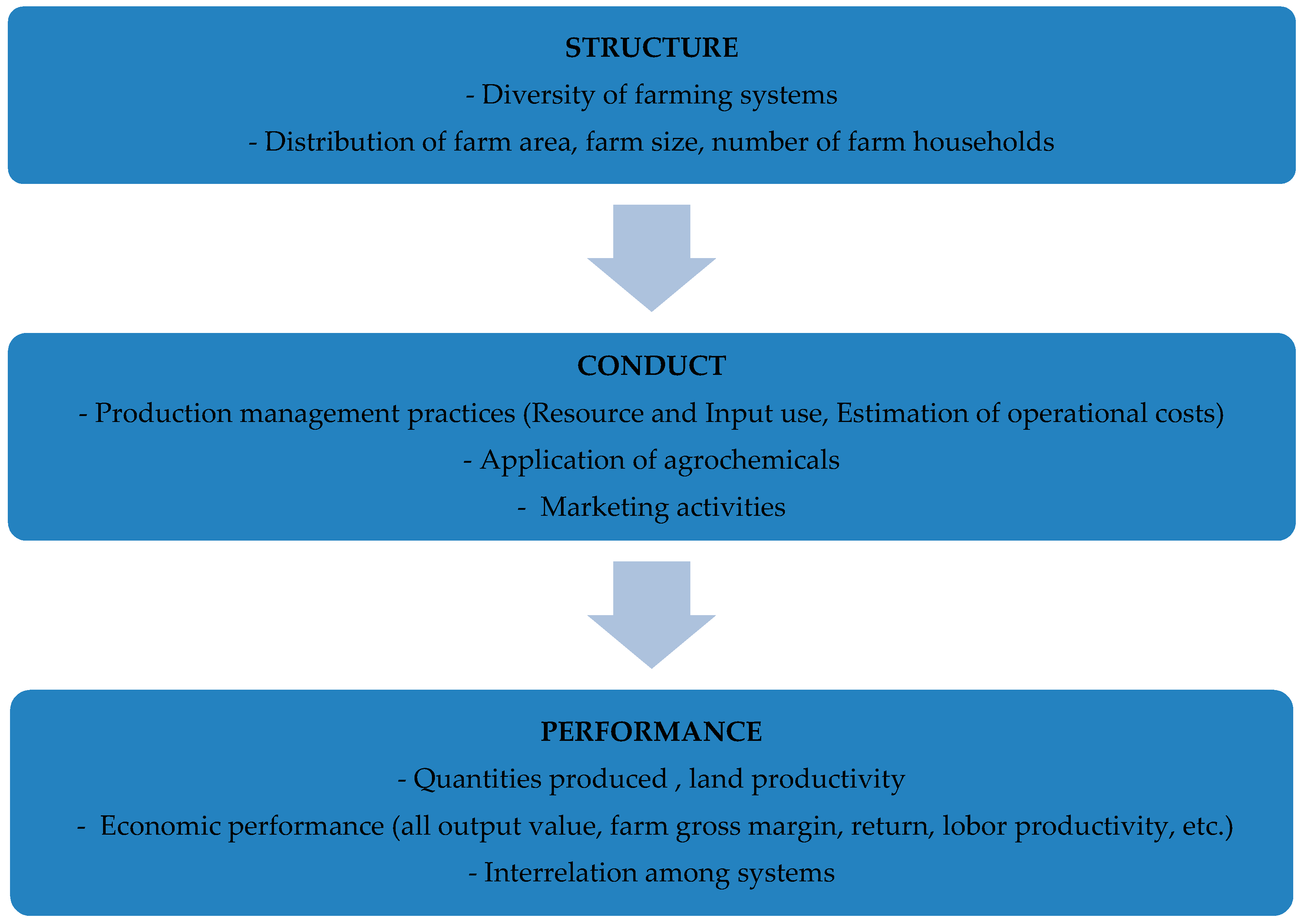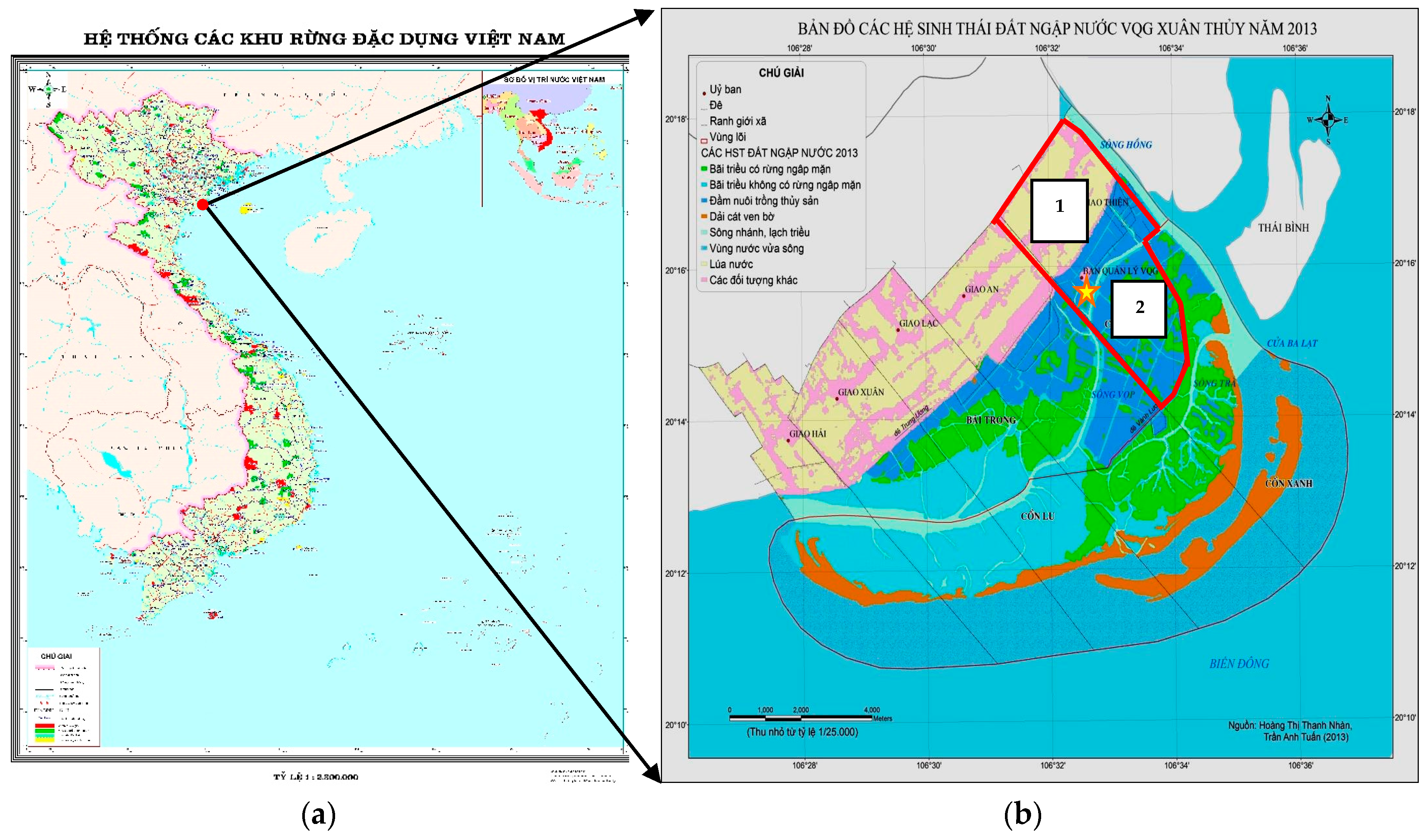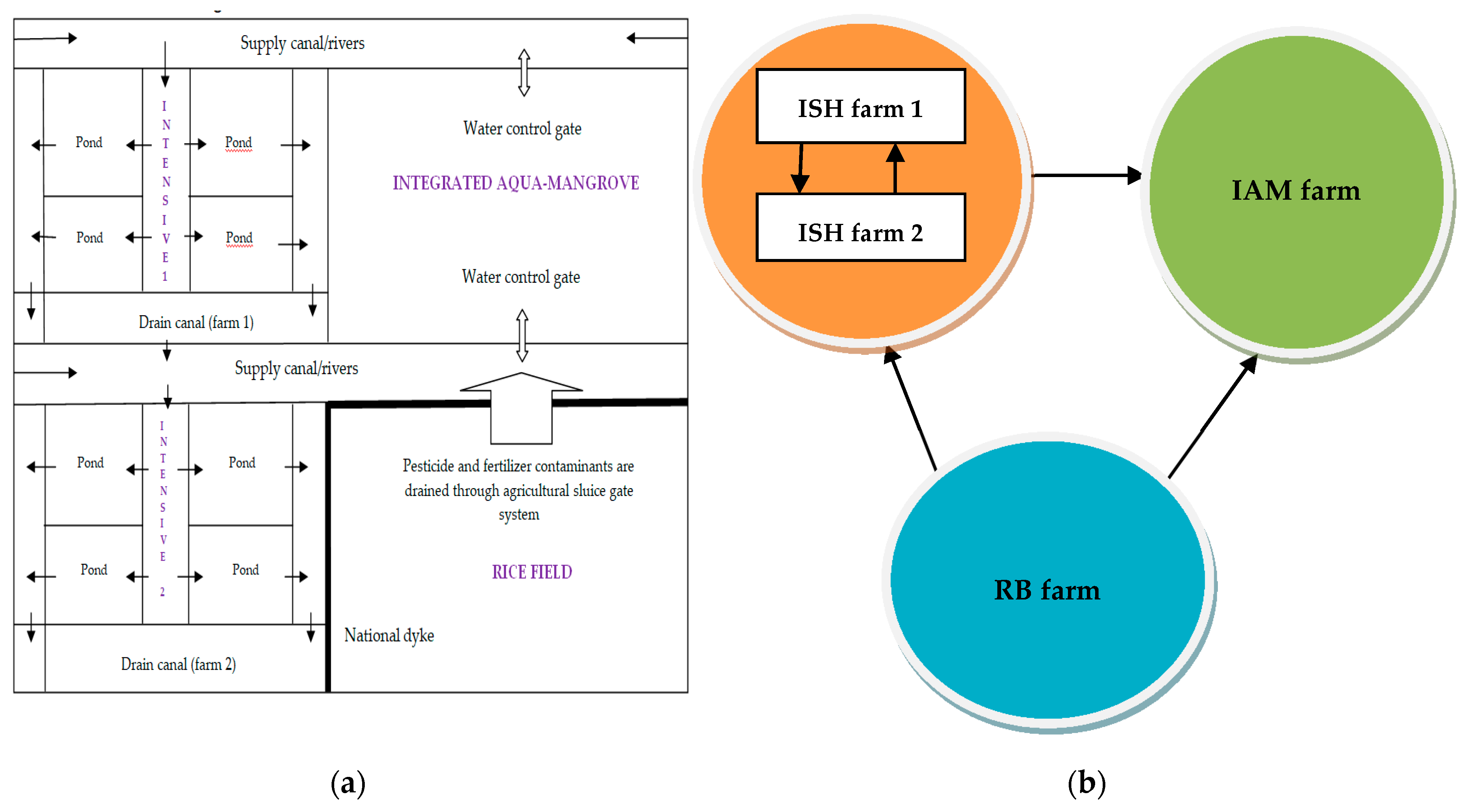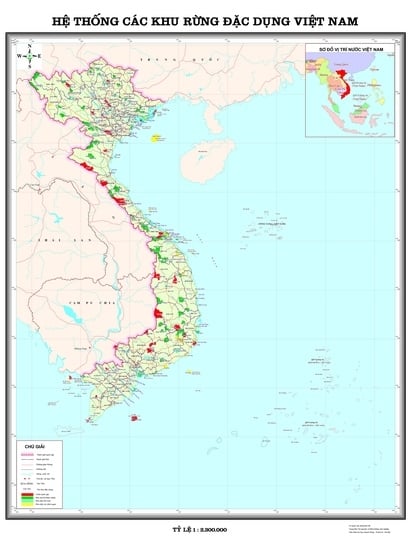Dynamics of Farming Systems under the Context of Coastal Zone Development: The Case of Xuan Thuy National Park, Vietnam
Abstract
1. Introduction
2. Materials and Methods
2.1. Conceptual Framework
2.2. Xuan Thuy National Park
2.3. Data Source and Sampling
2.4. Data Analysis
3. Results and Discussion
3.1. Structure
3.1.1. Integrated Aquaculture–Mangrove (IAM) System
3.1.2. Intensive Shrimp (ISH) System
3.1.3. Rice-Based (RB) System
3.2. Conduct
3.2.1. Resource Management
3.2.2. Cost Management
3.2.3. Use of Agrochemicals
3.2.4. Marketing Activities
3.3. Performance
3.3.1. Farm Outputs
3.3.2. Economic Performance
3.3.3. Interrelations between Systems
4. Recommendations
4.1. Marketing Activities, Diversifying Income Sources, and Cost Strategies
4.2. Environmentally Friendly Farming Practices and Management
5. Conclusions
Author Contributions
Funding
Conflicts of Interest
References
- Scialabba, N. Integrated Coastal Area Management and Agriculture, Forestry and Fisheries; Food & Agriculture Org: Rome, Italy, 1998. [Google Scholar]
- Vernier, F. Agriculture in Coastal Areas: Environmental Issues, Impacts and Regulation Tools; National Research Institute of Science and Technology for Environment and Agriculture: Antony, France, 2012. [Google Scholar]
- Dukes, M.D.; Evans, R.O. Impact of agriculture on water quality in the North Carolina Middle Coastal Plain. J. Irrig. Drain. Eng. 2006, 132, 250–262. [Google Scholar] [CrossRef]
- Páez-Osuna, F.; Guerrero-Galván, S.R.; Ruiz-Fernández, A.C. The environmental impact of shrimp aquaculture and the coastal pollution in Mexico. Mar. Pollut. Bull. 1998, 36, 65–75. [Google Scholar] [CrossRef]
- Lewins, R. Coastal Aquaculture and Development-Planning for Sustainability; Centre for Environment and Society Occasional Paper; University of Essex: Colchester, UK, 2006. [Google Scholar]
- Lewis, R.R.; Phillips, M.J.; Clough, B.; Macintosh, D.J. Thematic Review on Coastal Wetland Habitats and Shrimp Aquaculture; Report prepared under the World Bank, NACA, WWF and FAO Consortium Program on Shrimp Farming and the Environment; Food and Agriculture Organization of the United Nations, the World Bank Group, World Wildlife Fund, and the Network of Aquaculture Centres in Asia-Pacific, 2003; Volume 81, Available online: https://enaca.org/?id=522 (accessed on 1 July 2019).
- Groupe Mixte D’experts Chargé D’étudier les Aspects Scientifiques de la Pollution des Mers. Planning and Management for Sustainable Coastal Aquaculture Development; FAO—Food and Agriculture Organization of United Nations: Rome, Italy, 2001. [Google Scholar]
- Gowing, J.; Tuong, T.; Hoanh, C.T. Land and Water Management in Coastal Zones: Dealing with Agriculture, Aquaculture, Fishery Conflicts; CAB International: Wallingford, UK, 2006. [Google Scholar]
- Can, N. Transformation of Farming Systems in Coastal Mekong Delta: Seeking for Better Management and Sustainability. In Proceedings of the 6th International Symposium on Structural Transformation of Vietnamese Agriculture and Rural Society in the Period of Globalization, Industrialization, Modernization, Kagoshima University, Kagoshima, Japan, March 2011. [Google Scholar]
- Hossain, M.; Ut, T.; Bose, M. Livelihood systems and dynamics of poverty in a coastal province of Vietnam. In Environment and Livelihoods in Tropical Coastal Zones: Managing Agriculture–Fishery–Aquaculture Conflicts; CAB International: Wallingford, UK, 2006; pp. 30–47. [Google Scholar]
- Gowing, J.W.; Tuong, T.P.; Hoanh, C.T.; Khiem, N.T. Social and environmental impact of rapid change in the coastal zone of Vietnam: An assessment of sustainability issues. In Environment and Livelihoods in Tropical Coastal Zones: Managing Agriculture–Fishery–Aquaculture Conflicts; CAB International: Wallingford, UK, 2006; pp. 48–60. [Google Scholar]
- Khai, H.V.; Yabe, M. Choice modeling: Assessing the non-market environmental values of the biodiversity conservation of swamp forest inVietnam. Int. J. Energy Environ. Eng. 2014, 5, 77. [Google Scholar] [CrossRef]
- Seto, K.C.; Fragkias, M. Mangrove conversion and aquaculture development in Vietnam: A remote sensing-based approach for evaluating the Ramsar Convention on Wetlands. Glob. Environ. Chang. 2007, 17, 486–500. [Google Scholar] [CrossRef]
- Haneji, C.; Vu, D.L.; Duong, T.H. Composing biodiversity indicators for the conservation of mangrove ecosystem in Xuan Thuy National Park, Vietnam. J. Vietnam. Environ. 2014, 6, 101–108. [Google Scholar]
- Tanaka, K. Transformation of Rice-Based Cropping Patterns in the Mekong Delta: From Intensification to Diversification. Jpn. J. Southeast Asian Stud. 1995, 33, 368–378. [Google Scholar]
- Chand, P.; Sirohi, S. Development and application of an integrated sustainability index for small-holder dairy farms in Rajasthan, India. Ecol. Indic. 2015, 56, 23–30. [Google Scholar] [CrossRef]
- Hai, H.T.; Nhan, H.T.T. Hiện Trạng đa Dạng Sinh học của Vườn Quốc gia Xuân Thủy, Tỉnh Nam Định; Hồng Đức in Vietnamese: Ha Noi, Vietnam, 2015; pp. 1–199. [Google Scholar]
- Haneji, C. Analysis of Environmental Stressors on Ecosystems of Xuan Thuy National Park, Vietnam. J. Vietnam. Environ. 2014, 5, 12–21. [Google Scholar] [CrossRef]
- Nhan, H.T.T. Research on Indicators of Biodiversity of Wetland: Study in Xuan Thuy National Park. Ph.D. Thesis, Ha Noi National University, Ha Noi, Vietnam, 2014. [Google Scholar]
- Beland, M.; Goita, K.; Bonn, F.; Pham, T.T.H. Assessment of land-cover changes related to shrimp aquaculture using remote sensing data: A case study in the Giaothuy District, Vietnam. Int. J. Remote Sens. 2006, 27, 1491–1510. [Google Scholar] [CrossRef]
- Nhuan, M.T.; Ngoc, N.T.M.; Huong, N.Q.; Hue, N.T.H.; Tue, N.T.; Ngoc, P.B. Assessment of Vietnam Coastal Wetland Vulnerability for Sustainable Use (Case Study in Xuanthuy Ramsar Site, Vietnam). J. Wetl. Ecol. 2009, 2, 1–16. [Google Scholar] [CrossRef]
- Mai, T.N.; Nguyen, T.M.N. Geochemical Sedimentary Evolution Features of the Processes Of Formation, Development and Degradation of Mangrove Forests in Namdinh Coastal Region, Vietnam; Annual Report of FY 2001, The Core University Program between Japan Society for the Promotion of Science (JSPS) and National Centre for Natural Science and Technology (NCST); Osaka University: Osaka, Japan, 2003; pp. 137–148. [Google Scholar]
- Vietnam-Netherland Water Partnership on Water for Food and Ecosystem (WFE), Integrated and Sustainable Use of Water Resources for Maintaining Ecosystems of Xuan Thuy National Park; Vietnam Institute of Water Resources Research: Ha Noi, Vietnam, 2008.
- Manyong, M.A.; Degand, J. Sustainability of African Smallholder Farming Systems. J. Sustain. Agric. 1995, 6, 17–42. [Google Scholar] [CrossRef]
- Mekonnen, M.; Keesstra, S.D.; Baartman, J.E.; Ritsema, C.J.; Melesse, A.M. Evaluating sediment storage dams: Structural off-site sediment trapping measures in north west Ethiopia. Cuad. Investig. Geográfica 2015, 41, 7–22. [Google Scholar] [CrossRef]
- Rodrigo-Comino, J.; Seeger, M.; Senciales, J.M.; Ruiz-Sinoga, J.D.; Ries, J.B. Spatial and temporal variation of soil hydrological processes on steeps lope vineyards(Ruwel-MoselValley, Gemany). Cuad. Investig. Geogr. 2016, 42, 281–306. [Google Scholar] [CrossRef]
- Hack-tenBroeke, M.J.; Kroes, J.G.; Bartholomeus, R.P.; Dam, J.C.V.; deWit, A.J.; Supit, I.; Walvoort, D.J.; Bakel, P.J.T.; Ruijtenberg, R. Quantification of the impact of hydrology on agricultural production as a result of too dry, too wet or too saline conditions. Soil 2016, 2, 391–402. [Google Scholar] [CrossRef]
- Talukder, B.; Saifuzzaman, M. Sustainability of agricultural systems in the coastal zone of Bangladesh. Renew. Agric. Food Syst. 2016, 31, 148–165. [Google Scholar] [CrossRef]
- Mason, E.S. Price and production policies of large-scale enterprise. Am. Econ. Rev. 1939, 29, 61–74. [Google Scholar]
- Bain, J.S. Relation of profit rate to industry concentration: American manufacturing, 1936–1940. Q. J. Econ. 1951, 65, 293–324. [Google Scholar] [CrossRef]
- Gali, J.; Tate, C.; O’Sullivan, M. Structural Analysis of Agriculture: A Methodological Perspective; Univesity of Queensland: Sydney, Australia, 2000. [Google Scholar]
- Ngigi, M. Structure, Conduct and Performance of Commodity Markets in South Sudan: Linkages Food Security; Famine Early Warning Systems Network: Washington, DC, USA, 2008. [Google Scholar]
- Banson, K.E. Systemic approach to examine the structure, conduct and Performance model of agriculture in Africa, evidence from Ghana. In Proceedings of the 59th Annual Meeting of the ISSS-2015, Berlin, Germany, 2–7 August 2015. [Google Scholar]
- Banson, K.E.; Nguyen, N.C.; Bosch, O.J.; Nguyen, T.V. A systems thinking approach to address the complexity of agribusiness for sustainable development in Africa: A case study in Ghana. Syst. Res. Behav. Sci. 2015, 32, 672–688. [Google Scholar] [CrossRef]
- Hampel-Milagrosa, A. Institutional Economic Analysis of Vegetable Production and Marketing in Northern Philippines: Social Capital, Institutions and Governance; Wageningen University: Wageningen, The Netherlands, 2007. [Google Scholar]
- Lal, R.; Miller, F.P. Sustainable farming systems for the tropics. In Proceedings of the 1st International Symposium on Natural Resources Management for a Sustainable Agriculture; Sustainable Agriculture: Issues, Perspectives and Prospects in Semi Arid Tropics; Indian Society of Agronomy: New Delhi, Indian, 1990; Volumes 1–2, pp. A69–A89. [Google Scholar]
- Fresco, L.; Westphal, E. A hierarchical classification of farm systems. Exp. Agric. 1988, 24, 399–419. [Google Scholar] [CrossRef]
- Rana, S. Farming Systems and Sustainable Agriculture; College of Agriculture, CSK Himachal Pradesh Krishi Vishvavidyalaya: Palampur, India, 2011. [Google Scholar]
- Smith, C.; McDonald, G. Assessing the sustainability of agriculture at the planning stage. J. Environ. Manag. 1998, 52, 15–37. [Google Scholar] [CrossRef]
- Gaviglio, A.; Bertocchi, M.; Demartini, E. A tool for the sustainability assessment of farms: Selection, adaption and use of indicators for an Italian case study. Resources 2017, 6, 60. [Google Scholar] [CrossRef]
- Reidsma, P.; König, H.; Feng, S.; Bezlepkina, I.; Nesheim, I.; Bonin, M.; Sghaier, M.; Purushothaman, S.; Sieber, S.; VanIttersum, M.K.; et al. Methods and tools for integrated assessment of land use policies on sustainable development in developing countries. Land Use Policy 2011, 28, 604–617. [Google Scholar] [CrossRef]
- Zhen, L.; Zoebisch, M.A.; Chen, G.; Feng, Z. Sustainability of farmers’ soil fertility management practices: A case study in the North China Plain. J. Environ. Manag. 2006, 79, 409–419. [Google Scholar] [CrossRef] [PubMed]
- Waney, N.F.L.; Soemarno; Yulity, Y.; Polii, B. Developing Indicators of Sustainable Agriculture at Farm Level. J. Agric. Vet. Sci. 2014, 7, 42–53. [Google Scholar]
- Nambiar, K.K.M.; Gupta, A.P.; Fu, Q.; Li, S. Biophysical, chemical and socio-economic indicators for assessing agricultural sustainability in the Chinese coastal zone. Agric. Ecosyst. Environ. 2001, 87, 209–214. [Google Scholar] [CrossRef]
- Castellini, C.; Boggia, A.; Cortina, C.; DalBosco, A.; Paolotti, L.; Novelli, E.; Mugnai, C. A multicriteria approach for measuring the sustainability of different poultry production systems. J. Clean. Prod. 2012, 37, 192–201. [Google Scholar] [CrossRef]
- Jane Dillon, E.; Hennessy, T.; Buckley, C.; Donnellan, T.; Hanrahan, K.; Moran, B.; Ryan, M. Measuring progress in agricultural sustainability to support policy-making. Int. J. Agric. Sustain. 2016, 14, 31–44. [Google Scholar] [CrossRef]
- Pham, L.V.; Smith, C. Agricultural sustainability in developing countries: An assessment of the relationships between drivers and indicators in Hoa Binh Province, Vietnam. Agroecol. Sustain. Food Syst. 2013, 37, 1144–1186. [Google Scholar] [CrossRef]
- Vietnam Administration of Forestry. National Parks of Vietnam; Vietnam Association of National Park and Nature Reserve: HaNoi, Vietnam, 2017. [Google Scholar]
- Namdinh Provincial Statistical Office. Statistics of Giaothuy District; Namdinh provincial Statistic Office: Namdinh, Vietnam, 2016. [Google Scholar]
- Yamane, T. Statistics: An Introductory Analysis; Harper and Row: New York, NY, USA, 1973. [Google Scholar]
- McConnell, D.J.; Dillon, J. Farm Management for Asia: A Systems Approach; Food & Agriculture Org.—Food and Agriculture Organization of the United Nations: Rome, Italy, 1997. [Google Scholar]
- Breslow, N. A generalized Kruskal-Wallis test for comparing K samples subject to unequal patterns of censorship. Biometrika 1970, 57, 579–594. [Google Scholar] [CrossRef]
- Minh, T.; Yakupitiyage, A.; Macintosh, D. Management of the Integrated Mangrove-Aquaculture Farming Systems in the Mekong Delta of Vietnam; Integrated Tropical Coastal Zone Management, School of Environment, Resources, and Development, Asian Institute of Technology: Khlong Nueng, Thailand, 2001. [Google Scholar]
- Hanh, H.Q.; Azadi, H.; Dogot, T.; Ton, V.D.; Lebailly, P. Dynamics of agrarian systems and land use change in North Vietnam. Land Degrad. Dev. 2017, 28, 799–810. [Google Scholar] [CrossRef]
- Rana, S.; Chopra, P. Integrated Farming System; Department of Agronomy, College of Agriculture, CSK Himachal Pradesh Krishi Vishvavidyalaya: Palampur, India, 2013. [Google Scholar]
- Larsson, J.; Folke, C.; Kautsky, N. Ecological limitations and appropriation of ecosystem support by shrimp farming in Colombia. Environ. Manag. 1994, 18, 663. [Google Scholar] [CrossRef]
- Gatune, C.; Vanreusel, A.; Cnudde, C.; Ruwa, R.; Bossier, P.; DeTroch, M. Decomposing mangrove litter supports a microbial biofilm with potential nutritive value to penaeid shrimp post larvae. J. Exp. Mar. Biol. Ecol. 2012, 426, 28–38. [Google Scholar] [CrossRef]
- Thuy, H.T.T.; Loan, T.T.C. Antibiotic contaminants in coastal wetlands from Vietnamese shrimp farming. Environ. Sci. Pollut. Res. 2011, 18, 835–841. [Google Scholar] [CrossRef] [PubMed]
- Önder, M.; Ceyhan, E.; Kahraman, A. Effects of Agricultural Practices on Environment. Biol. Environ. Chem. 2011, 24, 28–32. [Google Scholar]
- Glover DFrancisco, H. Economy and Environment: Case Studies in Vietnam; EEPSEA: Ho Chi Minh City, Vietnam, 1999. [Google Scholar]
- Kamoshita, A.; Nguyen, Y.T.B. Preliminary Assessment of Rice Production in Coastal Part of Red River Delta Surrounding Xuan Thuy National Park, Vietnam, for Improving Resilience, in Resilient Asia; Springer: Tokyo, Japan, 2018; pp. 7–38. [Google Scholar]
- Department of Agriculture and Rural Development of Giaothuy District. Hướng dẫn thâm canh lúa mùa và lúa xuân theo hướng biến đổi khí hậu; Department of Agriculture and Rural Development of Giaothuy District: Namdinh, Vietnam, 2017. [Google Scholar]
- Department of Cropping and Plant Protection of Giaothuy District. Hướng dẫn diệt sâu bệnh, cỏ, Chuột cho lúa xuân và lúa mùa 2016–2017; Department of Cropping and Plant Protection of Giaothuy District: Namdinh, Vietnam, 2017. [Google Scholar]
- Thakur, K.; Patanasatienkul, T.; Laurin, E.; Vanderstichel, R.; Corsin, F.; Hammell, L. Production characteristics of intensive whiteleg shrimp (Litopenaeus vannamei) farming in four Vietnam Provinces. Aquac. Res. 2018, 49, 2625–2632. [Google Scholar] [CrossRef]
- Statistics of Land Use in Commune in Vietnam; Statistics office of Communal Buffer Zone: Hanoi, Vietnam, 2017.
- FAO. Statistic of Rice and Paddy Production. FAO. Available online: http://www.fao.org/faostat/en/#data/QC (accessed on 10 April 2019).
- Seafood Trade Intelligence Portal. 2018. Available online: https://seafood-tip.com/sourcing-intelligence/countries/vietnam/shrimp/mangrove/ (accessed on 10 April 2019).
- Cao, L.; Diana, J.S. Integrating Environmental Impacts, Productivity, and Profitability of Shrimp Aquaculture at the Farm-Scale as Means to Support Good Aquaculture Practices and Eco-Certification; Final Report: Investigation 2009–2011; University of Michigan: Ann Arbor, MI, USA, 2011. [Google Scholar]
- Engle, C.R.; McNevin, A.; Racine, P.; Boyd, C.E.; Paungkaew, D.; Viriyatum, R.; Tinh, H.Q.; Minh, H.N. Economics of sustainable intensification of aquaculture: Evidence from shrimp farms in Vietnam and Thailand. J. World Aquac. Soc. 2017, 48, 227–239. [Google Scholar] [CrossRef]
- Kautsky, N.; Rönnbäck, P.; Tedengren, M.; Troell, M. Ecosystem perspectives on management of disease in shrimp pond farming. Aquaculture 2000, 191, 145–161. [Google Scholar] [CrossRef]
- Ministry of Agriculture and Rural Development. Circular 22/2014/TT-BNNPTNP. National Technical Regulation on Brackish Water Shrimp Culture Farm—Conditions for Veterinary Hygiene, Environmental Protection and Food Safety; Ministry of Agriculture and Rural Development: Ha Noi, Vietnam, 2014.
- Council, N.R. Alternative Agriculture; National Academies Press: Washington, DC, USA, 1989. [Google Scholar]
- Bromley, D.W.; Chavas, J.-P. On Risk, Transactions, and Economic Development in the Semiarid Tropics. Econ. Dev. Cult. Chang. 1989, 37, 719–736. [Google Scholar] [CrossRef]
- Yi, Y.; Fitzsimmons, K. Tilapia-shrimp polyculture in Thailand. New dimensions in farmed tilapia. Proc. Ista 2004, 6, 777–790. [Google Scholar]
- Truong, T.D.; Do, L.H. Mangrove forests and aquaculture in the Mekong river delta. Land Use Policy 2018, 73, 20–28. [Google Scholar] [CrossRef]
- Boyd, C.E. Guidelines for aquaculture effluent management at the farm-level. Aquaculture 2003, 226, 101–112. [Google Scholar] [CrossRef]
- Hossain, M.; Uddin, M.; Fakhruddin, A. Impacts of shrimp farming on the coastal environment of Bangladesh and approach for management. Rev. Environ. Sci. Bio/Technol. 2013, 12, 313–332. [Google Scholar] [CrossRef]
- Ministry of Agriculture and Rural Development. Decree Number 22 on National Standard of Aquaculture Farming; Ministry of Agriculture and Rural Development: Ha Noi, Vietnam, 2014.
- Stafford, J.V. Implementing precision agriculture in the 21st century. J. Agric. Eng. Res. 2000, 76, 267–275. [Google Scholar] [CrossRef]
- Council, N.R. Toward Sustainable Agricultural Systems in THE 21st Century; National Academies Press: Washington, DC, USA, 2010. [Google Scholar]



| Farming Systems | Production Systems | Total Area | Total Farm Owners | No. of Respondents |
|---|---|---|---|---|
| Integrated aquaculture–mangrove | Shrimp–Crab–Mangrove | 816.2 | 102 | 84 |
| Intensive shrimp | Shrimp–Shrimp–Fallow | 150.37 | 64 | 54 |
| Rice-based | Rice–Rice–Fallow | 382.0 | 2737 | 96 |
| Total | 1348.2 | 2903 | 234 |
| IAM | ISH | RB | |
|---|---|---|---|
| 1. Land holding/owner (ha) | 6.82 | 1.60 | 0.18 |
| - in which, % mangrove | 24.78 | 0.00 | 0.00 |
| 2. Land prior | Mangrove and sedge | Aquaculture-rice | Rice |
| 3. Land fee (mil.VND/ha/year) | 0.00 | 1.5–6 | 0.5 |
| 4. Ecosystem fee | 0.00 | 0.00 | 0.00 |
| 5. Water source | Sea flow to Vop, Tra and other rivers | Sea flows to Vop and Tra river | Fresh water |
| 6. Water exchange (times/crop) | Tidal regime (48) | 7.2 | 30 |
| 7. Distance from farms to agricultural sluice gates (m) | 3050.60 | 1943.52 | 1020.21 |
| Items | IAM | ISH | RB |
|---|---|---|---|
| 1. Variable cost 1 | 6.34 | 597.98 | 44.87 |
| Hired labor | 0.11 | 30.19 | 3.32 |
| Post-larvae shrimps | 2.79 | 96.89 | - |
| -Post-larvae crabs | 2.48 | 0.00 | - |
| Rice varieties | - | - | 3.15 |
| Formulated feed/rice bran | 0.41 | 243.11 | - |
| Miscellaneous | 0.34 | 0.00 | - |
| Lime | 0.20 | 11.20 | - |
| Sand | 0.00 | 17.53 | - |
| Chlorine (bacteria, virus control) | 0.00 | 10.85 | - |
| Drugs (snail, fungi control) | 0.00 | 6.46 | - |
| Antibiotics | 0.00 | 42.33 | - |
| Probiotic | 0.00 | 39.78 | - |
| Supplement | 0.00 | 37.24 | - |
| Electricity | 0.00 | 57.32 | - |
| Oil | 0.00 | 6.97 | - |
| Fertilizers | 0.00 | 0.00 | 15.68 |
| Pesticides | 0.00 | 0.00 | 6.21 |
| Rented machinery | 0.00 | 0.00 | 16.50 |
| 2. Fixed cost (except depreciation) | 1.96 | 18.43 | 1.11 |
| Land rents (pay for private land owner) | 0.35 | 0.00 | 0.00 |
| Land rents (pay for government) | 0.00 | 1.50 | 1.11 |
| Excavator rents for maintaining pond’s ditches | 1.21 | 0.00 | 0.00 |
| Interest (pay for loan) | 0.40 | 16.93 | 0.00 |
| 3. Depreciation | 0.63 | 33.30 | 0.00 |
| Total cost | 8.93 | 649.71 | 45.96 |
| External input dependence (EID) | 70.99 | 92.03 | 97.61 |
| Indicators | RB | Local Standard Recommended [62] |
|---|---|---|
| Compound NPK | 399.73 | 694.50 |
| Urea (N) | 371.06 | 111.12 |
| Potassium (K) | 99.75 | 138.90 |
| IAM | ISH | RB | ||||
|---|---|---|---|---|---|---|
| Productivity (kg/ha/crop) | Price (1000 VND/kg) | Productivity (kg/ha/crop) | Price (1000 VND/kg) | Productivity (kg/ha/crop) | Price (1000 VND/kg) | |
| Target product | 69.89 | 260 | 3745 | 136.5 | 6225 | 10 |
| Co-products | ||||||
| Crab | 16.35 | 339 | - | - | ||
| Wild-catch shrimp | 49.07 | 129 | - | - | ||
| Wild-catch fish | 9.77 | 30 | - | - | ||
| Natural bivalve | 17.78 | 5 | - | - | ||
| Natural seaweed | 642.31 | 4.8 | - | - | ||
| Total | - | 3745 | 6225 | |||
| Indicators | Unit | IAM | ISH | RB | |
|---|---|---|---|---|---|
| 1 | All outputs * | mil./ha/year | 32.99 | 1017 | 124.79 |
| 2 | Variable cost * | mil./ha/year | 6.34 | 597.98 | 44.87 |
| 3 | Fixed cost (except depreciation) * | mil./ha/year | 1.96 | 18.43 | 1.11 |
| 4 | Depreciation * | mil./ha/year | 0.63 | 33.30 | 0.00 |
| 5 | Farm gross margin * | mil./ha/year | 26.65 | 418.59 | 79.92 |
| 6 | Farm net actual returns * | mil./ha/year | 24.69 | 400.16 | 78.81 |
| 7 | Farm net sustainable returns * | mil./ha/year | 24.06 | 366.86 | 78.81 |
| 8 | Sustainable family income * | mil./ha/year | 24.06 | 366.86 | 78.81 |
| 9 | Working hours of family labor * | hour/ha/year | 471.07 | 2847 | 3111 |
| 10 | Sustainable family income per family working hour | 1000 VND | 51.08 | 128.85 | 25.33 |
© 2019 by the authors. Licensee MDPI, Basel, Switzerland. This article is an open access article distributed under the terms and conditions of the Creative Commons Attribution (CC BY) license (http://creativecommons.org/licenses/by/4.0/).
Share and Cite
NGUYEN, T.T.N.; TRAN, H.C.; HO, T.M.H.; BURNY, P.; LEBAILLY, P. Dynamics of Farming Systems under the Context of Coastal Zone Development: The Case of Xuan Thuy National Park, Vietnam. Agriculture 2019, 9, 138. https://doi.org/10.3390/agriculture9070138
NGUYEN TTN, TRAN HC, HO TMH, BURNY P, LEBAILLY P. Dynamics of Farming Systems under the Context of Coastal Zone Development: The Case of Xuan Thuy National Park, Vietnam. Agriculture. 2019; 9(7):138. https://doi.org/10.3390/agriculture9070138
Chicago/Turabian StyleNGUYEN, Thi Trang Nhung, Huu Cuong TRAN, Thi Minh Hop HO, Philippe BURNY, and Philippe LEBAILLY. 2019. "Dynamics of Farming Systems under the Context of Coastal Zone Development: The Case of Xuan Thuy National Park, Vietnam" Agriculture 9, no. 7: 138. https://doi.org/10.3390/agriculture9070138
APA StyleNGUYEN, T. T. N., TRAN, H. C., HO, T. M. H., BURNY, P., & LEBAILLY, P. (2019). Dynamics of Farming Systems under the Context of Coastal Zone Development: The Case of Xuan Thuy National Park, Vietnam. Agriculture, 9(7), 138. https://doi.org/10.3390/agriculture9070138






